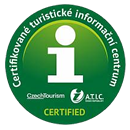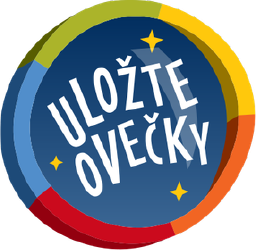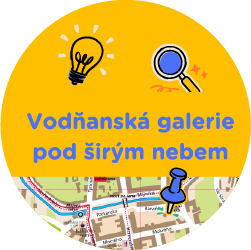Vodňany - The town surrounded by silver ponds, situated on the river Blanice (398 metres over the sea level) in the heart of southern Bohemia.
Fish farming tradition and opportunities for sports fishing in the picturesque landscape with loads of historical sights are the main reasons to visit this town and its surroundings. Since 1st January 2003 Vodňany, as the town with widespread competence, has been in charge of the present Vodňany region. It´s the member of the Blanice-Otava region which contributes to the rise of tourism in the region. In the town and annexed villages there live about 6500 inhabitants. Their ancestors are connected with a tale about “the clever ones from Vodňany”. 1646
there went the emperor Ferdinand III. through the muddy town. On the basis of the townspeople´s complaints about the lack of money for square cobblestones he decided to help them with money for useful thing. When visiting the town for the second time he found out, to his amazement, that new cobblestones were only in the streets (in front of the burghers´ houses) leading to the square which was still full of mud. Those ones then required a new contribution, because as it was said ”the emperor himself can see that he didn´t give enough money “. In this way Ferdinand III. paid for the cobblestones twice.
Historical sights
The town walls and a bridge over the millrace canal with St. John of Nepomuk statue.
Moated fortifications have survived all around the inner town. In the present form, with 4 preserved prismatic bastions they come from the 15th and 16th centuries, built on the older foundations. 3 medieval town gates (of Bavorov, Písek, Týn) and one modern one (New) were demolished in about 1840. A medieval technical relic with economic and defensive importance is the millrace along the north edge of the town core. Nearby the former Gate of Písek the canal is spanned by the low stone bridge with crucifix and the statue of St. John of Nepomuk (1730). This picturesque quiet place is called Vodňany Venice.
The Decanal Church of the Birth of Our Lady
The decanal church, built in the style of high Gothic in the 1st half of the 15th century by Mr. Jaklík and his son Václav at the place of the older building, established concurrently with the town. Situated at the north- west corner of the square. In the 80s of the 16th century the northern nave with an organ gallery and entrance hall was added to the church. The church was extensively damaged by fire in 1722, then it was restored. Apparently at this time the church tower was decorated by the municipal coats of arms. It was the “kingdom” of the Czech and at that time also a dean Vokoun. It was thoroughly re-Gothicized in 1894-1897 by R. Stech according to the designs of J. Mocker. At the same time the interior was decorated by the mural frescos, the Rennaissance gables on the west front were decorated with graffitos and the windows in presbytery with window paintings after the designs of Mikoláš Aleš. It was furnished with pseudo-Gothic furnishings. On the vault over the high altar there are painted 4 carps of Vodňany. Aleš´s original sketches together with the individual items of the original movable chattels can be found and seen in the collections of the museum and gallery. In the 64-meter high tower there hang 6 bells, the largest one – Marek- was casted in 1725. At the south foot of the church there stands the missionary cross from 1853. Next to it, on the surface, there is the mark in memory of the bell called Jan, which was smashed taking down for war purposes in 1917.
The Church of St. John the Baptist
Originally the hospice and cemetery church, dated back to 1414. Original plain gothic building, which used to stand in the middle of the cemetery, was pulled down in 1843 because of the unsatisfactory technical condition. The present empire church, built after the designs of J. Sandner, was consecrated in 1848. The altarpiece of the Christening of the Lord Jesus was given to the church by the empress Caroline Augusta. Most of the furnishings are of the neo-Rennaissance and neo-baroque origin. In front of the church there stands the forged cross from the year 1847 with a newer statue of Jesus Christ. Adjoining cemetery was, after the winding up in the 80s of the 20th century, converted into a sacred place. Only the graves of the Herites family, the Mokrý family and neo-gothic dean tomb have kept preserved. Since 2005 it has been called The Park of John Paul II.
The Chapel of St. Adalbert (Vojtěch)
Founded and built in 1730 – 1732 by Kristian Jonáš. The furnishings come from the 18th century. To the chapel there was removed the cemetery which has been in use since 1960 together with the ceremonial hall. John Huss´ Community Centre …of the Czechoslovak Hussite Church was built since 1923. The opening ceremony was held in 1925. Neighbouring the old cemetery there rises the atypical 20-meter high tower, crowned with a gilded cup on the top. In the building there is to be found the parish office of the Czechoslovak Hussite Church.
The former synagogue
The plain building in the classicist style. Since its completion in 1860 to the 2nd WW it served for the divine services of the local Jewish religious community. After the improvements in 1959 it has been used as the exhibition area of the town museum. Behind the former synagogue there is the building of the former Jewish school from 1868.
The Fountain in the Square of Liberty
Adapted in 1928 according to the design of J. Kvasnička, the author of the allegorical statue of Liberty. Under the statue on the middle column there can be seen both the municipal coat of arms and symbols of the activities done in the town – fish farming, agriculture and industry.
The Memorial Plaque
On the occasion of the 50th anniversary of the end of the 2nd WW there was unveiled the memorial plaque on the building of the Savings Bank in the square (No 24). It commemorates the meeting of commanders of the allied armies in Vodňany. The memorial to the casualties of the 1st and 2nd WW can be found in the pak at the bus station.
The Town Museum and Gallery
In 1895, supported especially by the writers J. Zeyer, F. Herites and O. Mokrý, there was organized the ethnographic exhibition collecting the first items of the future museum collection. Its installation was realized 10 years later in the Town Hall. The first custodian of the new museum was a teacher Haštal Mostecký, who took the main credit for development of the museum between two wars. Since 1959 the museum has used the premises of the former synagogue. From the 1st May until the end of September it is possible to visit the exposition called The Fishing Tradition in Vodňany about the local fish farming, fishing and miller´s trade. It is always created in cooperation with The Secondary Fisheries School and The Research Institute of Fish Culture and Hydrobiology. All the year round in the Town Hall there is opened the Town Gallery, founded by dr. B. Žahour in 1967. He gave to his birth town 158 paintings by 95 Czech painters of the turn of the 19th and 20th centuries (O. Blažíček, V. Brožík, O. Bubeníček, A. Kalvoda, Fr. Kaván, K. V. Mašek, J. Panuška, Jos. Ulman, J. Úprka, Fr. Ženíšek …). His act insipred a lot of other donors and thanks to them there came to being the valuable collection of works of art, which has been supported by the goal-directed purchases since 1992 made by the Foundation of Zdeněk Novák and his wife Marie.
The largest collection of the drawings is on the show in the Hall of Mikoláš Aleš (1852-1913). They are the designs and sketches for the decoration of the Decanal church in Vodňany and the school in Protivín. The Memorial Hall of František Herites (1851-1929) introduces a Vodňany native, a pharmacist, a writer of the novels set in the small town, a literary editor, for the certain time also a mayor of the town and especially a leader of the cultural events in Vodňany. The furniture and the things from the Herites family estate create the atmosphere of the town household of the end of the 19th century. Remarkable is also the large family library, where are hidden lots of foreign-language publications, but especially the presents from their literary friends with the personal dedications. The Memorial Hall of Julius Zeyer (1841-1901) gets to know the 19th century Czech literature important personality.
This writer lived in Vodňany in 1887-1889 predominantly in the baroque house “U čápů” and he was a friend of F. Herites and O. Mokrý (1857-1899). Enchanted by this small town and his surroundings he made a lot of his friends visit it (Z. Braunerová, A. Chittussi, F. Bílek, A. Hejduk) and he wrote many of his books here. Exhibited collection of ceramics, china, glass and textile introduces Zeyer as a passionate collector and traveller. Neo-Rennaissance furniture from the 80s of the 19th century tells us not only about the taste of the owner but also about the need of the men´s household of that time. In the lecture room there are shown the portraits and personal things of Vodňany personalities (J. Zrzavý, O. Mokrý, B. Žahour, V. Kopista)




